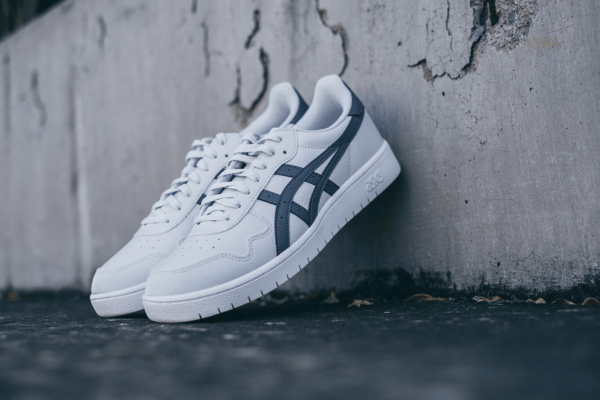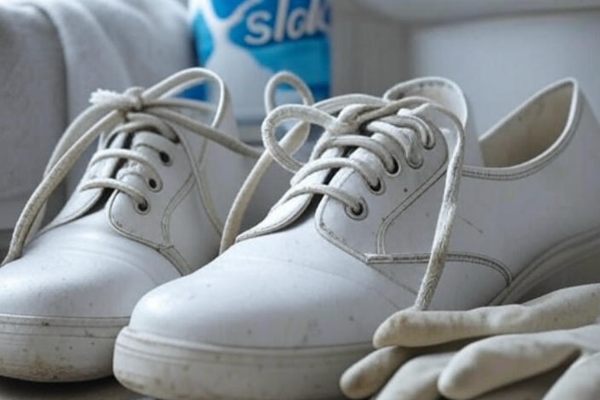🔹 Introduction
When it comes to foot health, support is everything—and it starts with your shoes. While most people focus on shoe size or brand, few realize that knowing how to improve shoe support with lacing can make a major difference.
Using the right lacing method doesn’t just improve fit; it can enhance comfort, prevent pain, and even correct poor alignment. In fact, studies show that proper lacing matters for foot health, especially for those with foot conditions or active lifestyles.
So, does shoe lacing affect support? Absolutely. In this guide, we’ll show you how small lacing changes can lead to big improvements in stability, comfort, and overall foot performance.
🔹Why Lacing Matters More Than You Think
Many people underestimate the impact of how they lace their shoes. The way you lace your shoes has a significant impact on your posture, comfort, and overall foot health. Incorrect lacing can cause discomfort, pressure spots, and misalignment and may even contribute to long-term balance or stability problems. That’s why understanding shoe-lacing techniques for support is more important than ever—especially if you’re struggling with discomfort.
So, does shoe lacing affect support? Absolutely. Tight spots, loose zones, or uneven tension can all reduce the shoe’s ability to provide proper cushioning and alignment. On the other hand, well-planned ways to lace shoes for better support can improve how your shoes hug your feet, reduce slippage, and support the arch, heel, and ankle.
Not only that, but how different lacing styles affect comfort is something backed by both experience and podiatric research. For example, people with flat feet, wide feet, or high arches often benefit from specific lacing patterns that relieve pressure in sensitive areas.
More importantly, why proper lacing matters for foot health comes down to injury prevention and long-term comfort. Shoes that fit better thanks to strategic lacing can reduce friction, control pronation, and even improve athletic performance.
Still wondering, can lacing reduce foot pain? Yes, it can. When done correctly, lacing can ease discomfort by redistributing pressure and preventing unwanted movement inside the shoe.
In short, if you truly want to improve shoe support with lacing, it’s not just about style—it’s about smart technique. Take time to explore different shoe-lacing techniques for support, and choose what fits your foot’s unique shape and needs.
🔹Best Lacing Methods for Different Foot Types
Not all feet are the same—and that’s why a one-size-fits-all lacing technique doesn’t work for everyone. Whether you have flat feet, wide feet, or need extra ankle and heel support, the way you lace your shoes can make a huge difference. Understanding the best lacing method for your foot shape is a key step in learning how to improve shoe support with lacing. Below, we break down the ideal lacing methods for different foot types to enhance comfort, reduce pain, and improve stability.
Flat Feet Support
Flat feet need extra arch support to reduce stress and fatigue during walking or running. Traditional lacing patterns often don’t provide the midfoot support needed.
- Best lacing method for flat feet support: Use a technique that tightens across the midfoot while allowing flexibility in the toe and heel areas. The “ladder lacing” or “parallel lacing” style works well.
- How to lace shoes for arch support: Begin by skipping the bottom eyelets to reduce pressure on the arch. Focus tension on the middle rows to create more structure beneath the foot.
By adapting the lacing this way, you can improve arch alignment and overall foot stability.
Wide Feet Comfort
Shoes that feel too tight across the sides can cause pain, blisters, or restricted movement. Proper lacing can open up space and relieve pressure points.
- How to lace shoes for wide feet: Skip eyelets near the toes to give more space at the forefoot. The “gap lacing” technique, or “diagonal lacing,” is ideal.
- Adjust lacing for different foot shapes: Use open-lacing styles to reduce compression and allow more room across the widest part of your foot. Avoid crisscross patterns that pull the sides inward.
These methods offer more breathing room while still keeping your shoe secure.
Heel and Ankle Support
If your heel slips out or your ankle feels unstable, lacing adjustments can give better lock-in and reduce the risk of injury.
- How to lace shoes for heel support: Use the “heel lock” or “runner’s loop” lacing to anchor your heel firmly in place and prevent slipping.
- How to lace shoes for ankle support: Lace all the way up to the top eyelets and apply even pressure from the ankle up. This supports lateral movement and stabilizes your joints.
For athletes and hikers, this type of lacing can be crucial to long-term foot health.
Final Tip: Customizing your lacing based on your foot shape is a smart, low-cost way to improve shoe support with lacing. The right method can enhance fit, reduce pain, and keep your feet supported throughout the day.
Upgrade your look with 10 cool shoelace styles that combine fashion and function.
From streetwear to sports, these creative lacing methods make your shoes stand out.
👉 See the full style guide now on 10 cool shoelace styles.

🔹How to Fix Common Fit Issues Using Lacing
Even the best shoes can feel uncomfortable if the lacing isn’t right. Whether you’re dealing with loose shoes, heel slipping, or painful pressure points, the right lacing method can dramatically improve your fit and comfort. Let’s explore smart lacing strategies to solve these common issues and improve overall shoe support with lacing.
Fixing Loose Shoes
If your shoes feel too loose, especially around the midfoot or heel, lacing can help you create a more secure fit. Try the lock lacing technique or tighten the eyelets nearest the ankle. These small adjustments can prevent your foot from sliding forward and help you fix loose shoes with laces without needing insoles or heel grips.
Pro tip: Lacing tighter near the ankle and looser at the toe box balances support and comfort.
Prevent Heel Slipping
Heel slippage is a common issue—especially when breaking in new shoes or wearing low-cut sneakers. One of the most effective ways to stop heel slipping in shoes is by using a heel lock (runner’s loop) lacing technique. This method secures your heel in place while minimizing unnecessary tension across the top of your foot.
Why it works: It enhances rearfoot stability and improves overall fit during walking or running.
Reduce Pressure Points & Discomfort
Foot pain often comes from tight spots or uneven pressure. If you’re wondering how to reduce pressure points in shoes, start by adjusting the lacing tension across specific zones. For example, skip eyelets in high-pressure areas or use parallel lacing to distribute tension evenly.
These strategies help prevent foot pain with shoe lacing and support natural foot movement—especially helpful for runners or those on their feet all day.
Improve Overall Shoe Support
To improve shoe support with lacing, you must understand the anatomy of foot pressure and how lacing impacts it. Proper lacing supports the foot’s natural arch, reduces strain on joints, and keeps your heel, ankle, and forefoot aligned.
Different foot types require different lacing techniques:
- For wide feet, consider skipping the lower eyelets or loosening the laces around the midfoot for a more comfortable fit.
- Narrow feet: Use criss-cross lacing with tighter loops.
- High arches: Loosen the middle section for better flex.
Comparing regular vs. supportive lacing styles, supportive lacing focuses on customizing the fit based on individual foot structure, which helps prevent long-term injuries and discomfort.
Incorrect lacing doesn’t just affect comfort—it impacts foot alignment, stability, and posture. Poor lacing can cause imbalanced pressure, leading to fatigue and chronic foot pain.
Summary
Whether you need to fix loose shoes, prevent heel slipping, or reduce pressure points, lacing techniques are a powerful tool to improve shoe support. By choosing the right method for your foot type and adjusting for pressure zones, you ensure both comfort and foot health.
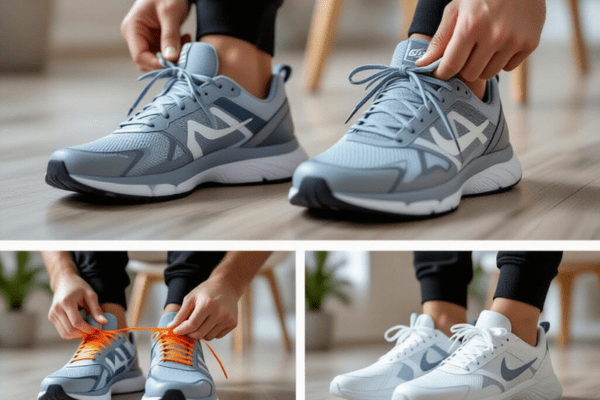
🔹Common Lacing Mistakes to Avoid
Lacing your shoes may seem simple, but doing it incorrectly can cause more harm than good. Many people overlook the importance of proper lacing, which directly impacts comfort, foot health, and even posture. Let’s explore the most common lacing mistakes that reduce support—and how you can fix them.
1. Lacing Too Tight or Too Loose
When your laces are too tight, they can restrict blood flow, cause pressure points, and worsen conditions like plantar fasciitis. On the other hand, loose laces fail to secure your foot, leading to instability and heel slippage. The proper way to lace shoes for support is to find a balance—your shoes should feel snug but never painful.
2. Ignoring Your Foot Shape
Many people use a standard lacing pattern regardless of foot type. This is a big mistake. Flat feet, high arches, wide feet, or plantar fasciitis all require different lacing approaches. If you want to improve shoe support with lacing, adapt your method to your unique foot needs.
Try specific foot-support shoe-lacing tricks that reduce pain and increase stability.
3. Skipping Eyelets
Some runners or walkers skip the top eyelets to save time or for style. However, using all the eyelets helps lock the heel in place, preventing unnecessary movement and blisters. Especially for people dealing with lacing for plantar fasciitis, heel lock lacing can make a huge difference.
4. Not Re-Lacing After Break-In
Once shoes start to wear in, the fabric and fit change. Re-lacing to match the new shape of your shoe ensures continued support. Don’t keep your lacing pattern static—adjust it over time for better comfort.
5. Ignoring Discomfort
If your shoes constantly hurt or feel unbalanced, the lacing might be to blame. Always troubleshoot discomfort with different techniques. Sometimes, a small change in the pattern or tension can completely change how your shoe feels.
Pro Tip:
If you’re wondering how to improve shoe support with lacing, always match your lacing technique with your activity (running, walking, or standing) and foot type. A small adjustment today can prevent big problems tomorrow.
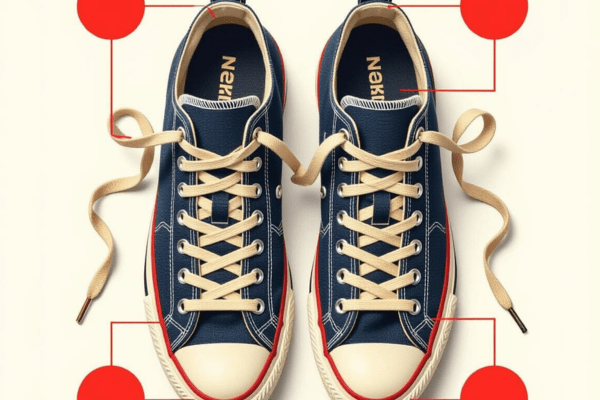
🔹 Choosing the Right Lacing Method for You
Finding the right lacing method can make a big difference in how your shoes feel and perform. Whether you have flat feet, experience heel slippage, or just want a snugger fit, the way you lace your shoes plays a crucial role in comfort and support.
So, what lacing method is best for support? The answer depends on your foot type and the activity you’re doing.
If you have flat feet, look for lacing tips for flat feet that help add midfoot support and reduce arch strain. For example, skipping eyelets near the arch or using a ladder lacing pattern can evenly distribute pressure and improve overall balance.
Those who deal with loose shoes or unwanted foot movement should consider tight lacing for a better fit. This approach secures the foot in place, minimizes friction, and improves stability—especially during high-impact activities like running or hiking.
Here’s a quick side-by-side look: Standard vs. Supportive Lacing Styles:
- Regular lacing often focuses on speed or style but may overlook proper fit.
- Supportive lacing styles are purpose-driven, tailored to foot shape, and can help reduce pain, slippage, and pressure points.
Ultimately, the best lacing method is the one that supports your specific foot structure and activity level. Don’t hesitate to experiment with different patterns to find what feels right—because your feet deserve personalized comfort.
Discover pro tips and proven techniques at BestShoeLaces.com to improve comfort, fit, and foot support.
From daily wear to performance needs—we’ve got every lacing style covered.
👉 Visit now: bestshoelaces.com
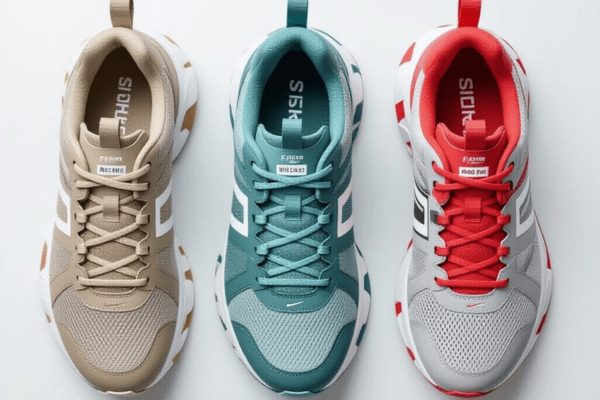
🔹Final Tips for Better Foot Health
When it comes to maintaining healthy feet, proper shoe fit is just as important as the lacing method you choose. Even the most advanced lacing techniques won’t help if your shoes are too tight, too loose, or simply worn out. That’s why it’s essential to check your shoe fit regularly and make small adjustments to improve both comfort and support.rn out. That’s why it’s essential to check your shoe fit regularly and make small adjustments to improve both comfort and support.
Check Your Fit Regularly
Many people unknowingly wear the wrong shoe size, which can lead to blisters, heel slipping, and arch pain. If your toes feel cramped or your heels constantly lift, you’re likely facing one of the common shoe-fitting issues. These problems can often be fixed with the right lacing method tailored to your foot type and shoe shape.
Use Supportive Insoles
Another overlooked solution is using arch-supporting insoles. These can drastically improve foot alignment and reduce pressure points, especially for those with flat feet or plantar fasciitis. Pairing the right insole with the correct lacing method ensures that your feet are well-supported throughout the day.
Don’t Ignore Your Laces
Worn-out or stretched laces can reduce your shoe’s ability to stay snug, making your lacing technique less effective. Replace your laces regularly, especially if you notice fraying or uneven tension when tying them.
And if you’re wearing sneakers, don’t just rely on the factory lacing. Learn how to lace sneakers for extra support—whether you’re walking, running, or training, custom lacing patterns can make a significant difference in both performance and comfort.
🔹Conclusion
If you’re looking for a simple yet effective way to enhance comfort and reduce foot pain, learning how to improve shoe support with lacing is a great place to start. The right lacing technique can correct poor fit, support your unique foot shape, and prevent common issues like heel slipping or pressure points.
Whether you have flat feet, high arches, or just want a more secure fit, customizing your lacing method makes a noticeable difference. Combine smart lacing with good insoles and proper shoe sizing, and you’ll set yourself up for better performance and long-term foot health.
Start experimenting with different lacing styles today—your feet deserve the support.
🔹FAQs
Q1: Does shoe lacing really affect support?
Yes, the way you lace your shoes can significantly impact foot support. Proper lacing helps distribute pressure evenly, improves stability, and prevents unnecessary movement inside the shoe—reducing the risk of blisters, foot fatigue, and injury.
Q2: What is the best way to lace shoes to prevent pain?
The best lacing method depends on your specific pain points. For example, “heel lock lacing” helps with heel slipping, while “window lacing” eases pressure on the top of the foot. Customizing your lacing style based on foot shape can relieve common issues like arch pain and toe cramping.
Q3: Can different lacing styles help with foot conditions?
Absolutely. Specific lacing patterns can provide relief for foot conditions like plantar fasciitis, flat feet, high arches, or bunions. Paired with supportive insoles, the right lacing technique can reduce pain and improve overall comfort during daily wear or workouts.
Q4: What can I do to keep my shoes from slipping off my heel?
To keep your heel secure and prevent your shoes from slipping, try using the heel lock method, also called the runner’s loop lacing technique. It secures your ankle more tightly without overtightening the rest of the shoe, offering better grip and reducing rubbing that leads to blisters.
Q5: When is the right time to change your shoelaces to maintain proper support?
It’s best to replace your shoelaces every 6 to 12 months, or sooner if you notice fraying, uneven tension, or difficulty keeping your shoes snug. Fresh laces maintain consistent support and ensure your chosen lacing method remains effective over time.

